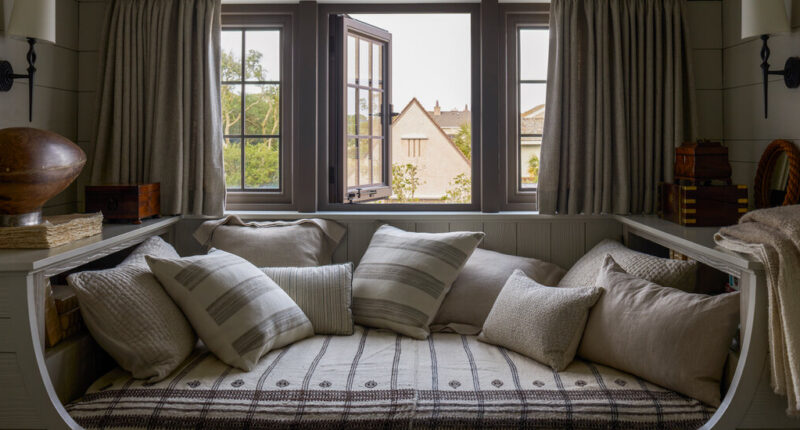
With summer travel in full swing, many of us will welcome houseguests in the coming weeks. But when friends and family arrive with overnight bags, they also come with a question: Where will everyone sleep?
A dedicated guest room is the obvious answer — if you’re fortunate enough to have one. But it isn’t always the best use of space when you don’t have guests. And it probably won’t be capable of containing a larger crowd.
Don’t worry: There are many other ways to add occasional sleeping spaces to a home.
“Since the pandemic, people are asking about multiuse spaces more than ever,” said Max Humphrey, an interior designer based in Portland, Ore.
It’s not that hard to combine a sleeping space with the functions of an office, media room or exercise room, Mr. Humphrey noted: “A lot of the time, it’s about prioritizing a room for the main activity and then finding a solution for the couple of times a year it needs to host someone.”
He and other designers shared their secrets for accommodating overnight guests when space is at a premium.
Consider a Pullout
The conventional option for a temporary sleeping space is the sleeper sofa, long maligned for causing restless nights and sore backs.
“They’re like the worst of both worlds — an uncomfortable sofa and an uncomfortable bed,” Mr. Humphrey said.
But some are much better than others. The key is to try them out, or at least be aware of the quality, before you buy.
Ginger Curtis, the founder of Urbanology Designs in Fort Worth, chose a marigold-colored sleeper sofa from Clad Home to anchor the main living space of a guest cottage behind her house. “They just had a higher-quality mattress, so comfort isn’t an issue,” said Ms. Curtis, who also likes sleeper sofas from Interior Define.
Whenever she makes a sleeper sofa into a bed, she adds a pillowy mattress topper. “My kids, even when we don’t have guests, will request to pull it out for movie night,” she said.
There are also convertible sofas that don’t rely on a folding metal armature. Instead, they have cushions that slide or flip out to form a mattress, creating an uninterrupted cushion for those who don’t mind sleeping a few inches off the floor. Examples include the Twilight sleeper sofa from Design Within Reach (from $2,795), Thataway from Blu Dot ($2,195), Alesso from CB2 ($2,199) and vintage leather options by Giovannetti and de Sede.
Or Try a Trundle
Ms. Curtis also likes trundle beds. She installed one in the vacation cottage that she rents out just outside of Fort Worth. One of the small bedrooms is furnished with a twin bed, so she added a custom-made trundle bed underneath.
“It’s out of the way when it’s not being used,” she said. “But then you literally double the sleeping space in a very, very small area.”
Camp on a Cot
Rollaway beds and air mattresses can accommodate extra guests in a pinch, but they don’t exactly scream “comfort” or “fun.” If you’re going to set up a temporary bed, why not do something that will delight your guests?
Mr. Humphrey recently published a book on the historic interiors of National Park lodges (“Lodge: An Indoorsy Tour of America’s National Parks”), so it’s not surprising that he likes to offer his guests a camp-style cot. “I think it should feel like camping when you stay at a friend’s house for the night,” he said. “So I lean into that. It’s more fun than your average guest-room pullout.”
He uses a Byer of Maine wooden folding cot (about $200) with a fabric sling. But he added a personal touch: His local upholstery shop made a cushioned top with a skirt that he puts over the cot. “That just elevates the design and gives it a little personality,” he said. Also, it makes the cot more comfortable.
Find a Big Bench Seat
Don’t assume that your guest bed has to pull out, flip out, roll out or unfurl in some other manner. When rooms need to do double duty, many designers choose a sofa or daybed with a deep bench-style seat cushion that approximates the dimensions of a twin mattress.
If you have one large seat cushion on your sofa instead of several smaller ones, you can use it the same way you would a single mattress. “I have that in my own TV room at home,” said Natalia Miyar, an interior designer based in London and Miami. “I can buy sheets for it. Even my mother has stayed there.”
Mark Cunningham, a New York designer, did something similar for a client in the West Village of Manhattan, installing two custom sofas, each with a twin-size seat cushion, between built-in shelving. The result: a guest room that doubles as a study.
“With this client, her kids are older, so she wanted a space for when her kids and kids’ friends come over,” said Mr. Cunningham, who added storage drawers underneath the sofas. “It feels like more than just a room of beds.”
Create a Window Nook
Another option is building a generously sized window seat that can serve as a place for reading and daydreaming during the day, and an extra bed at night.
Beth Webb, an interior designer in Atlanta, has designed homes that use window seats to maximize the number of people who can stay in one room, and to create sleeping space outside of guest rooms. For a home in Jackson Hole, Wyo., she designed a window seat with a twin mattress in the middle and padded benches on the ends, in front of a window looking out at the Tetons.
“So much of the time, it’s empty nesters with grandchildren who are doing this,” Ms. Webb said, explaining that the setup allows her clients to put their adult children and grandchildren in the same bedroom. “They dubbed this room the junior master, because it’s very gracious. The children actually draw straws to see who gets it.”
Working with D. Stanley Dixon Architect, she designed a similar window seat for a pool house on Kiawah Island, S.C. This one is in the vestibule just outside the bedroom, for a little separation.
In both cases, the window seats have built-in lighting and shelving that doubles as night stands.
Supersize It
What if you often have big crowds of overnight guests? Consider supersizing the window seat.
When Mr. Humphrey was designing a beach house in Manzanita, Ore., with Beebe Skidmore Architects, he included an enormous window seat that wraps around the living-and-dining room, under windows looking out to the water.
“It serves as living room seating and a dining bench,” Mr. Humphrey said. “But five kids could sleep there. It’s actually the best spot in the house.”
Ms. Miyar did something similar for a vacation home she designed on the Spanish island of Ibiza. “We created this snug that’s a television room, hangout space and end-of-the-evening cocktail lounge,” she said. But instead of chairs, she added an L-shaped built-in bench across two walls, using French mattresses as seat cushions. The room can sleep a few people after a night of partying, but the rest of the time it doesn’t look anything like a bedroom.
“I tell all my clients to design rooms for how you live 360 days a year, not just special occasions,” Ms. Miyar said. “We come up with creative ways to turn one room into something else, so it always has life.”
For weekly email updates on residential real estate news, sign up here.
Source: | This article originally belongs to Nytimes.com









